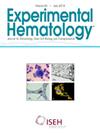Peposertib suppresses generation of FLT3-internal tandem duplication formed by contralateral double nicks
IF 2.1
4区 医学
Q2 HEMATOLOGY
引用次数: 0
Abstract
Fms-like tyrosine kinase 3-internal tandem duplication (FLT3-ITD) is the most frequent gene mutation in acute myeloid leukemia. The consequences of FLT3-ITD have been analyzed in detail; however, the molecular mechanisms underlying the generation of FLT3-ITD remain to be elucidated. We analyzed FLT3-ITDs in clinical samples using deep sequencing and identified not only oligoclonal ITDs but also rare deletion clones clustered at the palindrome-like sequence at FLT3 exon 14. We hypothesized that FLT3 exon 14 is genetically unstable due to the palindrome-like sequence at the region and that genomic damage at the site initiates FLT3-ITD formation. We used clustered regularly interspaced short palindromic repeats (CRISPR)/Cas9 to induce DNA damage for creating artificial FLT3-ITDs in human and mouse cell lines. We found that double nicks on the adjacent contralateral strand most efficiently generate ITDs. The artificial ITDs resembled clinical ITDs in the length distribution and characteristics at the joint. We further compared the inhibitory effects of olaparib and peposertib, specific inhibitors of single-strand break (SSB) and double-strand break (DSB) repair, respectively. Peposertib remarkably reduced ITD formation, but olaparib did not affect the mutation pattern. The findings indicated that nonhomologous end joining has a crucial role in the generation of ITDs. Our data shed light to the new role of peposertib, which potentially suppresses the generation of de novo FLT3-ITDs caused by mis-repair events of the DNA damages in a clinical course.
Peposertib抑制由对侧双切口形成的flt3 -内部串联重复的产生。
flt3 -内串联重复(ITD)是急性髓系白血病中最常见的基因突变。详细分析了FLT3-ITD的后果;然而,FLT3-ITD产生的分子机制仍有待阐明。我们利用深度测序技术分析了临床样本中的FLT3-ITDs,不仅发现了寡克隆ITDs,还发现了罕见的缺失克隆聚集在FLT3外显子14的回文样序列上。我们假设FLT3外显子14是遗传不稳定的,这是由于该区域的回文样序列,并且该位点的基因组损伤启动了FLT3- itd的形成。我们使用CRISPR/Cas9诱导DNA损伤,在人和小鼠细胞系中构建人工FLT3-ITDs。我们发现相邻对侧链上的双切口最有效地产生过渡段。人工过渡段在关节处的长度分布和特征与临床过渡段相似。我们进一步比较了单链断裂(SSB)和DSB修复特异性抑制剂olaparib和peposertib的抑制作用。Peposertib显著减少了ITD的形成,但olaparib不影响突变模式。研究结果表明,非同源末端连接在过渡段的产生中起着至关重要的作用。我们的数据揭示了peposertib的新作用,它可能抑制临床过程中DNA损伤错误修复事件引起的新生FLT3-ITDs的产生。摘要:FLT3-ITD是AML中最常见的突变,但其起源尚不清楚。通过深度测序,我们在FLT3外显子14的回文样序列上发现了罕见的缺失克隆聚集,表明遗传不稳定。CRISPR/ cas9诱导的DNA损伤显示,双切口有效地产生ITDs,类似于临床病例。Peposertib,一种DNA-PKcs抑制剂,显著减少了ITD的形成,突出了非同源末端连接的作用。我们的研究结果提示了一种潜在的治疗方法来预防AML中新生的FLT3-ITDs。
本文章由计算机程序翻译,如有差异,请以英文原文为准。
求助全文
约1分钟内获得全文
求助全文
来源期刊

Experimental hematology
医学-血液学
CiteScore
5.30
自引率
0.00%
发文量
84
审稿时长
58 days
期刊介绍:
Experimental Hematology publishes new findings, methodologies, reviews and perspectives in all areas of hematology and immune cell formation on a monthly basis that may include Special Issues on particular topics of current interest. The overall goal is to report new insights into how normal blood cells are produced, how their production is normally regulated, mechanisms that contribute to hematological diseases and new approaches to their treatment. Specific topics may include relevant developmental and aging processes, stem cell biology, analyses of intrinsic and extrinsic regulatory mechanisms, in vitro behavior of primary cells, clonal tracking, molecular and omics analyses, metabolism, epigenetics, bioengineering approaches, studies in model organisms, novel clinical observations, transplantation biology and new therapeutic avenues.
 求助内容:
求助内容: 应助结果提醒方式:
应助结果提醒方式:


